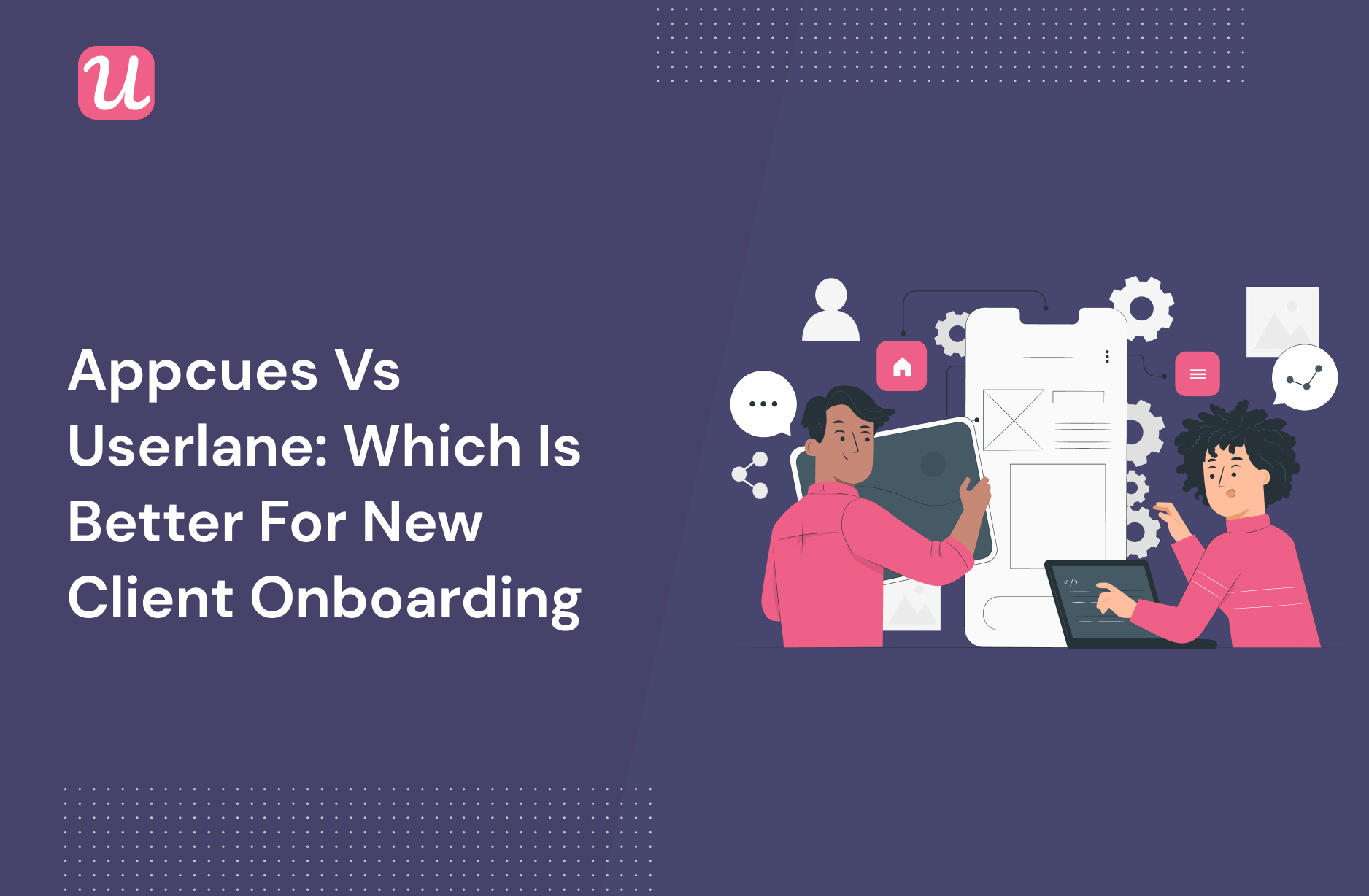
Appcues or Userlane: Which one is considered the best tool for new client onboarding? Or is there a better in-app onboarding software that would better suit your needs?
With so many alternatives on review sites, it’s a bit tricky to really choose one.
Think about what features you’ll need from the tool and what your priorities are. In addition, you need to make sure the price fits into your budget. Right?
In this post, we’ll discuss exactly that – what the perfect tool for new client onboarding should deliver and which will be the best choice for your company’s needs.
Let’s dive in!
Get The Insights!
The fastest way to learn about Product Growth, Management & Trends.
TL;DR
- A new client onboarding process involves introducing the company and product to the customer, answering questions, and guiding them through the process.
- The onboarding process is one of the most crucial phases for SaaS companies since it determines whether a customer stays or leaves.
- A good onboarding tool will help you create a great first impression and ensure a smooth onboarding process. In this way, you can create interactive walkthroughs and personalize customer journeys based on segmentation, as well as send microsurveys for customer feedback.
- With a mobile SDK, you can create targeted onboarding flows using slideouts, carousels, and push notifications without writing extra code.
- Appcues and Userlane are user onboarding tools that allow you to build product tours and interactive walkthroughs to onboard new customers.
- Though both are good tools in a SaaS market, they are not the right fit for everyone. For example, Appcues lacks certain transition actions like driven actions, scroll position, etc and their lowest plan is very limited.
- When it comes to Userlane, it offers only interactive walkthroughs, known as lanes. Apart from that, there is no Chrome Extension and it works only in the dashboard.
- Appcues and Userlane have a better alternative. Consider using Userpilot if you want to get the most out of your investment. This code-free tool allows you to create interactive and personalized onboarding experiences for new customers using a variety of UI patterns. Moreover, you will be able to use powerful segmentation and analytics features to better understand and serve your customers.
Looking for the best tool for new client onboarding? Search no more!

What is new client onboarding?
New client onboarding is a process that involves welcoming new clients, answering their questions, and ensuring they understand what your company offers. It’s usually delivered by Customer Success Managers for high-touch “white glove”client onboarding and may be automated for lower-ACV prosumer customers e.g. in SaaS.
Either way, it’s the time when your company establishes the relationship with your new client/customer, so it’s critical to get things right.
New clients might feel stressed about the onboarding time, wondering about the amount of time it will take them to truly understand and adopt your service/product, and feeling buyer’s remorse – whether they made the right choice and that you’re worth their time and money.
On the flip side, your customer success agents don’t know what the cooperation with the new client will be like, what are the client’s goals, and if it will be really possible to meet their expectations.
Let’s dive deeper into why new client onboarding is important, and how to get it right!
Why should you care about new client onboarding?
The new client onboarding phase is like the first date you may have with a new “romantic interest” – it’s a make-or-break few hours that determine if the next date is going to happen. Likewise, client onboarding may not last long, but it sets the stage for your whole relationship with that client.
Here’s why it’s so critical:
- The onboarding stage is a deciding factor for a lot of your clients whether to continue business with your company or not. According to Hubspot, 63% of customers consider the onboarding process when making a purchase.
- And no wonder – as the first interactions with your team, and whether there’s a lot of friction in the onboarding process or not – determine how your client perceives your company’s service level.
- Based on that, they would probably recommend your product/service to their friends or…not. So client onboarding also affects your Word of Mouth (WOM)
- This means that a bad client onboarding experience will likely leave you with poor reviews. And reviews on review sites like G2 or Capterra are an important deciding factor for most prospects considering your tool.
- Last but not least – the client onboarding phase affects the churn likelihood of your clients. If the goals are not set right in the onboarding phase, the expectations are not managed, and your client does not feel like they are reaching success – they will be more likely to feel disappointed in your product and churn.
Why do you need tools for new client onboarding?
Wondering why you even need a new client onboarding tool? There are several reasons why you may need one:
Let’s face it: you can’t provide a premium onboarding service to every client by hand, especially if you’re growing rapidly, and you’re selling to several client sectors.
And yet – considering what we discussed in the ‘importance of client onboarding’ – you really cannot afford to drop the ball on your ‘smaller’ users. So what can you do? To conduct new client onboarding well and reduce the friction for your new clients, you need the right onboarding tools
Here’s what the right new client onboarding tool that will allow you to do:
- Provide personalized onboarding flows that will be self-serve – will reduce the time your CSMs will need to spend with your clients explaining every feature of your product.
- Segment your users by company size, role, use case, and Job-to-be-done – to make sure you can deliver the right onboarding experiences to the right person, at the right time.
- Easily conduct surveys to understand your users’ goals, motivations, expectations, JTBDs, and desired outcomes.
- Track user journeys with simple user analytics and react to any problems as they arise.
- Provide self-serve support materials right inside your product, in a resource hub.
- Engage mobile app users by creating personalized messaging, push notifications, and surveys.
Your new client onboarding tools will allow you to do all the above synchronously, without having to deploy an army of CSMs on every single client.
Tool’s must-have features for new client onboarding?
Before picking your new client onboarding tool, you should check if it has most of the must-have features of a good onboarding tool:
Here’s what to look for before picking your client onboarding solution:
- Great segmentation capabilities – so you can segment your new clients by size, job to be done, role, use case, etc. – but also by in-app behavior.
- Ability to create no-code microsurveys – so you can easily collect additional information about your new clients that will help you customize their onboarding flows and experience.
- Features for creating no-code in-app experiences for onboarding: onboarding flows, checklists, tooltips, and modals.
- The option to create in-app resource centers for your new clients with multimedia content hubs – including help docs, knowledge base articles, video tutorials, as well onboarding flows. The knowledge hub should be available in-app and searchable by KWs.
- User analytics to monitor new client behavior inside your product, and catch customers that are failing to achieve their goals early – to offer them more personalized “human” support.
Appcues for new client onboarding
Appcues is another no-code user onboarding platform that helps non-technical teams track and analyze product usage. You can publish in-app onboarding tours, announcements, and launch surveys.
Unlike Userpilot, the functionality is limited if you are using the basic plans.
Appcues used to provide onboarding templates, which made it easy to use the tool. However, it provided a predefined way of thinking about onboarding all while having a higher price tag than other onboarding software. As of the time of writing (end of 2022), Appcues has removed its onboarding templates – without really replacing them with another solution.
Appcues allows you to design flows that make onboarding processes a breeze. These flows are what you use to create product tours and other in-app communication with users.
Here’s what you’ll get when you start using Appcues:
- Access to an easy-to-use UI that anyone on the team can handle for building in-app flows without coding.
- Building a product tour in Appcues is relatively easy. You just need to open their chrome extension on top of your application and start building your in-app experiences with a WYSIWYG editor. You simply select a UI pattern and customize it ‘live’, or point to the elements you want to e.g. append your tooltips to.
- Previously it was even easier – you chose one of its templates, they would basically create the product tour for you, and you just needed to customize each step. This limited the options for customizing but it was useful for beginners. We don’t know if Appcues plans to bring their templates back.
- You can also create checklists with Appcues (NOT available on the Essentials plan) and prompt users to take action. These are ok but have limited functionality (can’t trigger JS functions, or add gamification elements) compared to alternatives, such as Userpilot.
- Track UI engagement with Events explorer which allows you to tag elements without coding.
- Build custom user segments (up to 5 on the Essentials plan) based on user properties, flows, interactions, or events you set up in the events explorer.
Pros of Appcues?
Let’s look at some key advantages of Appcues:
- It makes it easy to build product tours with a user-friendly UI and predefined templates that can save you time.
- Can be used on web apps and mobile apps too.
- It integrates with most user analytics tools: Heap, Segment, Amplitude, and Mixpanel. This compensates a bit for the lack of in-depth analytics but means you need multiple subscriptions.
- You can use predefined flows or build your own using a good range of UI patterns.
- Allows basic segmentation and event-based flow triggering.
- It’s easy to build in-app surveys using modals or the integrated NPS tool.
Cons of Appcues?
But as any tool, Appcues is not without its flows – and at this price point, we think you may really want to consider some options that offer the same or more advanced functionality, but at a lower price tag:
- Appcues lacks certain transition actions like driven actions, scroll position, or page change, which would make product tours more interactive.
- It heavily limits the functionality available in the lowest (Essentials) plan. If you need checklists, more than 10 events, or more than 5 user segments, you’ll need to upgrade to the Growth plan (starting at $879/mo payable annually, which means you need to fork out more than $10,500 to start using Appcues for more use cases.
- Appcues doesn’t have a resource center feature, meaning you can’t use it to offer self-service support to your users.
What users say about Appcues?
What do Appcues users share about their experience? Overall users feel positive about Appcues.
Here’s an example summarizing some key points about its features and the value it offers. You can find more reviews on G2 or Capterra.
The best part of Appcues is the guided tour features which they call flaws. Especially on a team with limited resources, it allows you to improve your activation and engagement overnight by using this feature to guide your users around your product. What I love even more is the design and UX features are modern unlike other tour tools we’ve researched, and the software is easy-to-use with the need for a developer after the initial installation. – Raeann F.
However, there are some points that could be improved:
As with all software, you will run into irritating limitations. Appcues does collect a lot of data that could automatically be turned into user attributes (like the first log-in or visits per month) but they don’t do that. Jumping between the build mode and the studio can also become very confusing at times. – Ville T.
Is Appcues the right fit for your business?
There are good and bad when it comes to using Appcues but to sum it up, here’s why you might need an alternative:
- You need to build complex user flows and target them to specific user segments. In this case, you will need more than basic segmentation.
- You want to track product usage properly and don’t want to be limited by Appcues’s event explorer.
- You want to take full advantage of all onboarding functionalities (like a checklist) without paying a premium crazy price for them.
Appcues pricing
All things considered, Appcues does not offer the best value for money compared to some Appcues alternatives – at $249 per month. If your product has 2,500 active users, the costs for different plans are:
- Essentials: $249/month (Up to 3 user licenses)
- Growth: $879/month (Up to 10 user licenses)
- Enterprise: Custom (Unlimited user licenses)
There is a better tool for your SaaS than Appcues!

Userlane for new client onboarding
Userlane is a code-free digital adoption platform that allows you to create in-app interactive content to guide new users and increase product adoption.
Userlane offers all the basic things you need to create interactive in-app guidance and nail your onboarding.
Here is what you can get with Userlane:
- Create interactive in-app guides with modals, tooltips, and checklists to remove the guesswork and guide new customers step by step.
- Target guides, hints, and announcements to the right people at the right time to maximize engagement.
- You can also add videos, gifs, and links to enrich your in-app content.
- With the code-free editor, you can record the tutorials and share them with your users. With multiple language support, make sure that your customers get the in-app experiences in their languages.)
- However, Userlane allows you to only build logic flows (“lanes”) directly in the tool’s dashboard. It doesn’t work in a chrome extension by pointing and building UI patterns directly on top of your native UI (like e.g. in Userpilot).
Pros of Userlane
Userlane is a popular digital adoption tool and comes with many benefits. Here are its pros.
- Lanes are easy to set up and implement.
- Easy to add gamification elements to your onboarding.
- Includes real-time analytics so you can identify behavior trends and act on them.
- Doesn’t require technical knowledge as it’s mostly code-free.
Cons of Userlane
However, this tool has some flaws so it’s better to get an overview of its cons if you’re thinking of buying it:
- Not that many integration options. As of now, it has integrations with Confluence, Zendesk, and KnowledgeOwl.
- Some of the UI patterns, like hotspots and tooltips, aren’t as functional as users might like.
- Offers only interactive walkthroughs, known as lanes.
- Works only in the dashboard and can’t be launched in a Chrome extension as most of its competitors, as Userpilot does.
What users say about Userlane?
When it comes to reviews, customers are mostly enjoying a positive experience with Userlane. Here is what they say:
What I find most helpful about Userlane is its simplicity. In that I mean, it’s just easy to start using it out of the box and they continue to add great features all the time.
The tool is really intuitive to use and self-explanatory. Even multi-language support can be handled easily with hardly any effort. I also like the analytical options provided. Last but not least the service team is very supportive not only with technical questions but also in learning how to make the most out of the tool for our specific use cases.
We are using Userlane since almost two years and are always happy to implement the newest features. Big kudos to the Customer Support and Customer Success Team. If you need help, they help you almost instantly and provide easy-understandable solutions. I seldom worked with such a nice organization.
But at the same time, some customers are having complaints about the tool. Mostly they are related to a lack of user friendliness and difficulties for complete novices.
Here is what they say:
Sometimes it is quite complicated to build a guide within our software. But I think this depends on the structure of our software with so many iframes within iframes…
In general, Userlane offers far more advantages than disadvantages.
However, if there should be improvements from our point of view, then the analytics could be further expanded. They currently reflect a good status of the use of guided tours, but could be a little more detailed at one point or another.
The only thing that for me is frustrating at times, is that the actions bar is now located vertically on the screen, versus its previous location across the base of the screen.
This is not user friendly where needed to scroll up or down the page, which was possible previously, but not so easy now. Also the actions bar covers some of the page content, so have to regularly move the actions bar from left to right and vice versa
Is Userlane the right fit for your business?
Userlane is a good tool but it’s not perfect and might not be the right tool for everyone. Here is why you might think about exploring an alternative tool:
- You can only create interactive walkthroughs to guide your new customers and everything is done in the native dashboard and not in a chrome Extention.
- It doesn’t offer an in-app help center and there is no capability to provide self-service support.
- Pricing is high as it mainly targets enterprise accounts with more than 500 employees.
Userlane pricing
Userlane’s pricing is not public and you should reach out to their sales team to get a quote.
But keep in mind that it is based on two things: the number of guided users and the product features you want access to.
There is a better tool for your SaaS than Userlane!

Is there a better alternative for new client onboarding?
Appcues and Userlane are good tools for new client onboarding. We’ve seen how they compare to each other and what you can achieve with them. Call us biased, but if you’re looking for something better, Userpilot offers more value for your money than these tools.
Userpilot for new client onboarding
Userpilot is a powerful product adoption platform that enables you to quickly build personalized, flexible, contextually relevant in-app experiences targeted to different user segments – all without writing a line of code.
Userpilot was built specifically for SaaS product teams that want to improve their user onboarding experience and boost user activation.
You can build a huge variety of user onboarding experiences and in-app guidance flows without needing to code.
Here’s what you’ll get when you start using Userpilot:
- Forget about coding in-app experiences: Userpilot is a no-code solution and only requires your dev to install a line of javascript inside your app and for you to download a chrome extension that opens up the visual builder.
- Build in-app flows using the largest range of UI patterns (modals, slideouts, tooltips, hotspots, banners) and in-app onboarding experiences (checklists, microsurveys, NPS surveys, in-app resource center)
- Get access to a built-in NPS tool for collecting and analyzing user sentiment so you can improve your onboarding process based on real data.
- Create and track combinations of in-app events like clicks, hovers and form fills, and then analyze all these interactions under your own custom events, which can be built without code or API calls.
- Use advanced product analytics and in-app flows analytics to identify where users need help and create granular user segments to trigger in-app experiences contextually (segment based on user identification data, in-app engagement, custom events, clicks, hovers, form fills, user feedback responses, NPS scores and more)
- Enhance the onboarding experience with in-app help by launching a Resource Center directly inside your app. Add in-app guides, and video tutorials, and give users access to search the knowledge base or reach out to support. Self-service has never been easier.
The best user onboarding is contextual and it happens right where the users need it, inside your app. There isn’t a better user onboarding tool out there that offers more value for the money than Userpilot.
Schedule a demo with our team and get ready to build the best onboarding experiences your users have seen.
Pros of Userpilot
Userpilot has a number of advantages, especially for mid-market SaaS companies looking for a robust but at the same time very easy-to-use, a no-code tool for user onboarding, product adoption, and simplified product analytics. Let’s have a look at the pros of using Userpilot:
- No-code builder – Userpilot comes with an easy-to-use Chrome Extension builder.
- Multiple UI patterns – choose from a range of options to build customized flows: modals,
- slideouts, banners, tooltips, hotspots, and checklists are all at your disposal.
- UI patterns are not limited by plan – you get access to all of them on every single plan, meaning you get value even with the Traction plan (this is the entry-level one).
- Engaging walkthroughs and onboarding flows- build interactive walkthroughs targeted to distinct user segments.
- In-app help – build a resource center offering self-service support to your users, customize it with your branding, and select from a range of help options to boost user satisfaction (i.e. videos, in-app flows, chat, and more).
- Experimentation – built-in A/B testing for flows lets you explore and quickly iterate based on direct user behavior.
- Powerful feedback options- integrated NPS surveys with analytics and response tagging unlock insight into how your users feel.
- Advanced analytics and segmentation- analyze product usage and in-app flow engagement and build user segments using the data.
- Event tracking and feature tags- tag UI engagement (clicks, form fills, hovers) and group them into one custom event to track what really matters.
- More value with integrations- unlock value faster with built-in integrations with popular tools like Segment, Amplitude, Mixpanel, Kissmetrics, Intercom, Heap, and more.
Cons of Userpilot
Userpilot has a number of advantages, especially for mid-market SaaS companies looking for a robust but at the same time very easy-to-use, a no-code tool for user onboarding, product adoption, and simplified product analytics. Let’s have a look at the pros of using Userpilot:
- No-code builder – Userpilot comes with an easy-to-use Chrome Extension builder.
- Multiple UI patterns – choose from a range of options to build customized flows: modals,
- slideouts, banners, tooltips, hotspots, and checklists are all at your disposal.
- UI patterns are not limited by plan – you get access to all of them on every single plan, meaning you get value even with the Traction plan (this is the entry-level one).
- Engaging walkthroughs and onboarding flows- build interactive walkthroughs targeted to distinct user segments.
- In-app help – build a resource center offering self-service support to your users, customize it with your branding, and select from a range of help options to boost user satisfaction (i.e. videos, in-app flows, chat, and more).
- Experimentation – built-in A/B testing for flows lets you explore and quickly iterate based on direct user behavior.
- Powerful feedback options- integrated NPS surveys with analytics and response tagging unlock insight into how your users feel.
- Advanced analytics and segmentation- analyze product usage and in-app flow engagement and build user segments using the data.
- Event tracking and feature tags- tag UI engagement (clicks, form fills, hovers) and group them into one custom event to track what really matters.
- More value with integrations- unlock value faster with built-in integrations with popular tools like Segment, Amplitude, Mixpanel, Kissmetrics, Intercom, Heap, and more.
What users say about Userpilot
Let’s check what real users like about Userpilot.
Userpilot is an incredible, user-friendly software that allows us to create unforgettable experiences for our clients! From basic to complex experiences, we have been able to do them all with ease! I would highly recommend this software to anyone who wants to provide their clients or users with the best product tour experience. The possibilities of what you can create are endless! – Tayla G.
Userpilot is simple to set up, use, and does not require any dev – which means instant publishing. This is critical for us as a SaaS company that releases new features frequently; we need the ability to inform our customers of changes quickly, and doing this in our platform through Userpilot allows us to reach the right audience, at the right time, in the right place. There have been many awesome extra features we’ve discovered since coming on board, and it’s been great to see new features released frequently. The tool itself is intuitive and reliable. Having used similar products previously that were clunky and buggy this has really made us happy with our decision to move to Userpilot. – Melina K.
Get more value for your money with Userpilot!

Userpilot pricing
Userpilot offers flexible pricing based on your monthly active users (MAUs). Plans start at $299 per month for smaller teams and scale as your user base grows.
Below are the pricing tiers you can choose from:
- The Starter plan begins at $299/month (billed annually) for up to 2,000 monthly active users. It includes in-app user engagement, usage trend analysis, NPS surveys, and essential product analytics—ideal for mid-market SaaS teams getting started.
- The Growth plan starts at $799/month (billed annually) and adds advanced analytics, retroactive event auto-capture, in-app surveys, session replay, and more. It’s the most popular choice for growing teams that need deeper insights and scale.
- The Enterprise plan offers custom pricing and includes everything in Growth, plus bulk data handling, custom roles and permissions, SOC 2 Type 2 compliance, and enterprise-level support.

Conclusion
There you have it. It should be easier now to make an informed decision between Appcues and Userlane.
There isn’t a tool that is the best since both have advantages and disadvantages. It will depend on the product you are using and your current needs. If you want the best value for money, going with the alternative option would be our recommendation.
Want to see how Userpilot can help with new client onboarding? Book a demo below.
There is a better tool for your SaaS than Appcues!


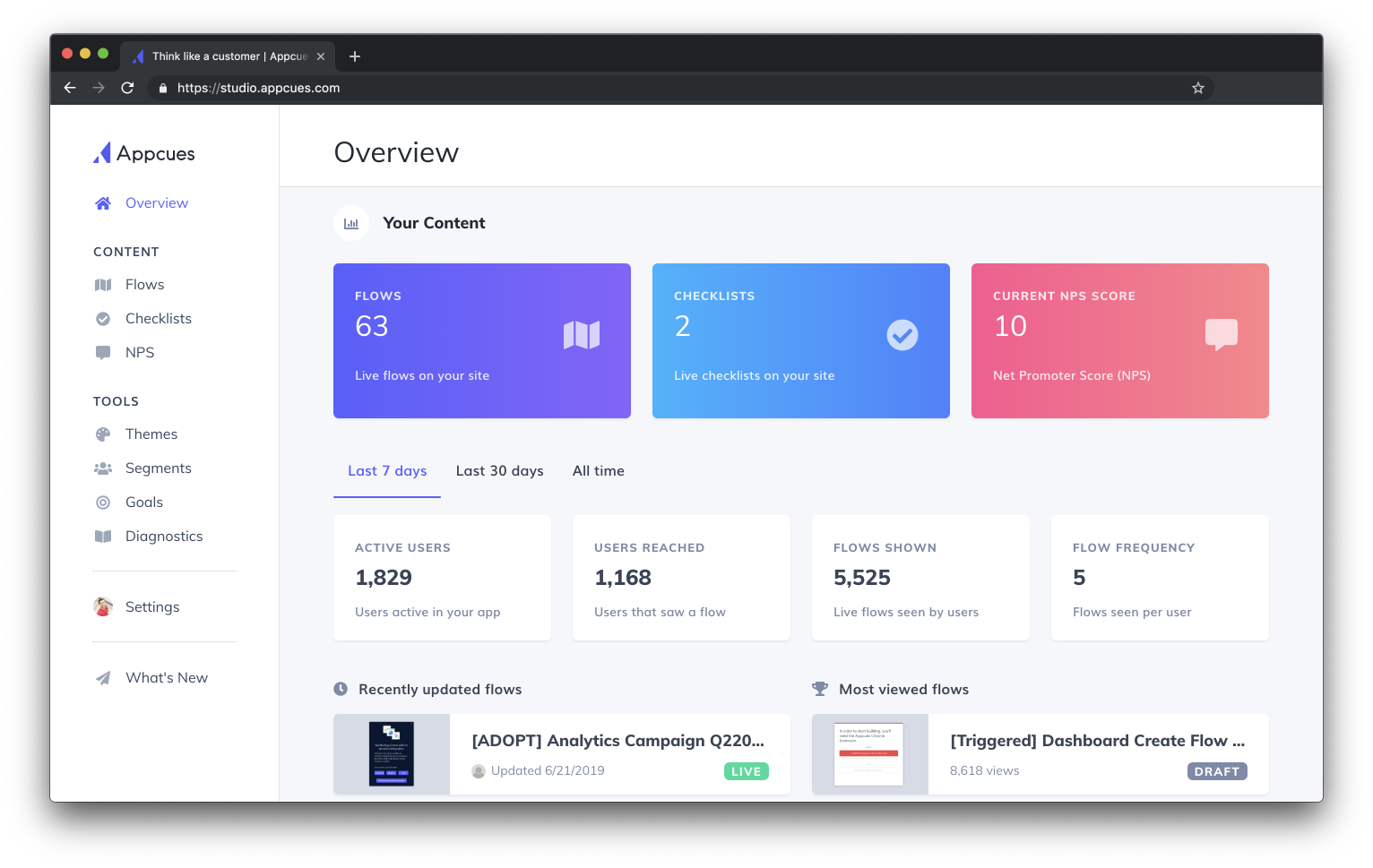
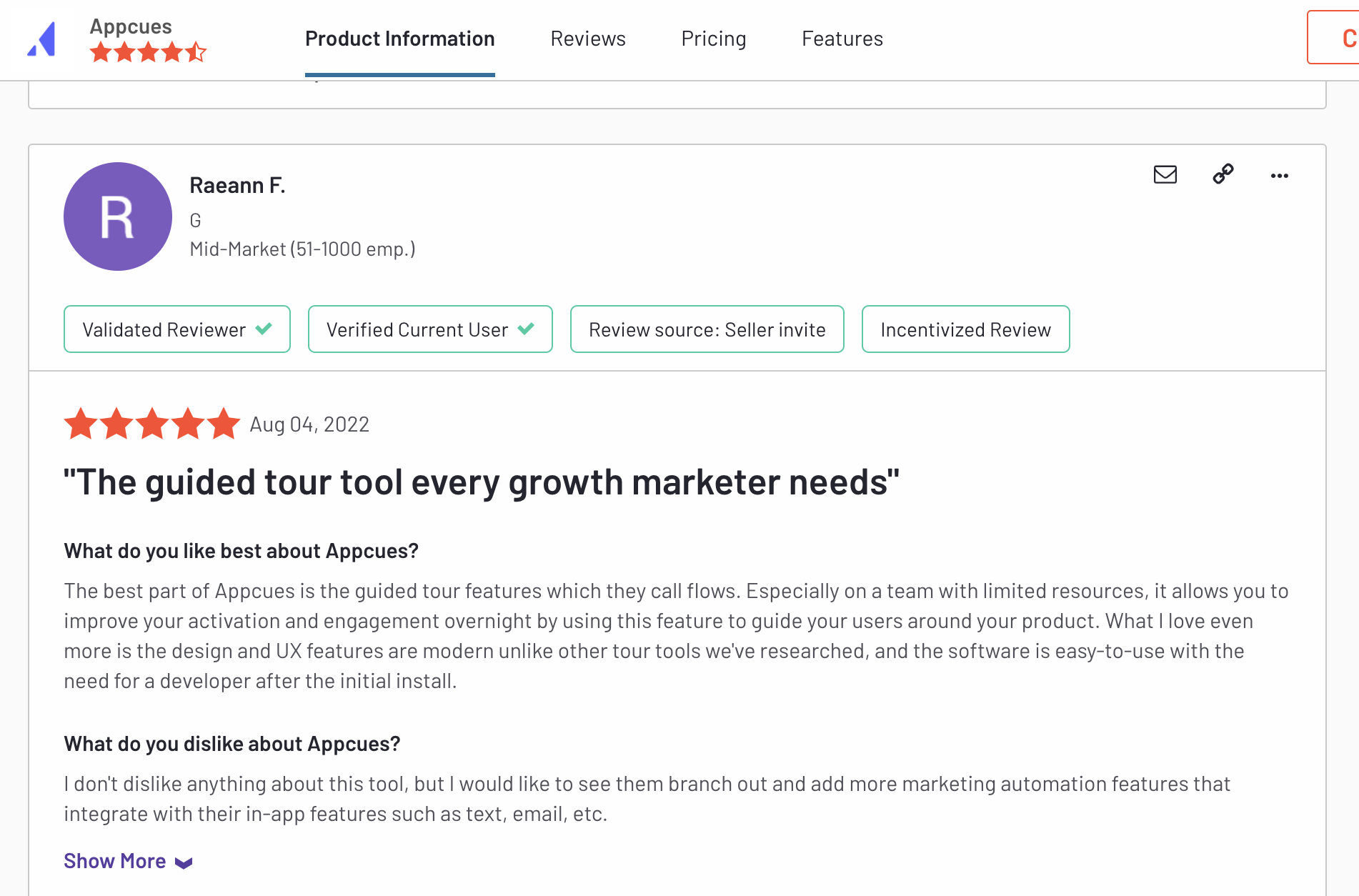
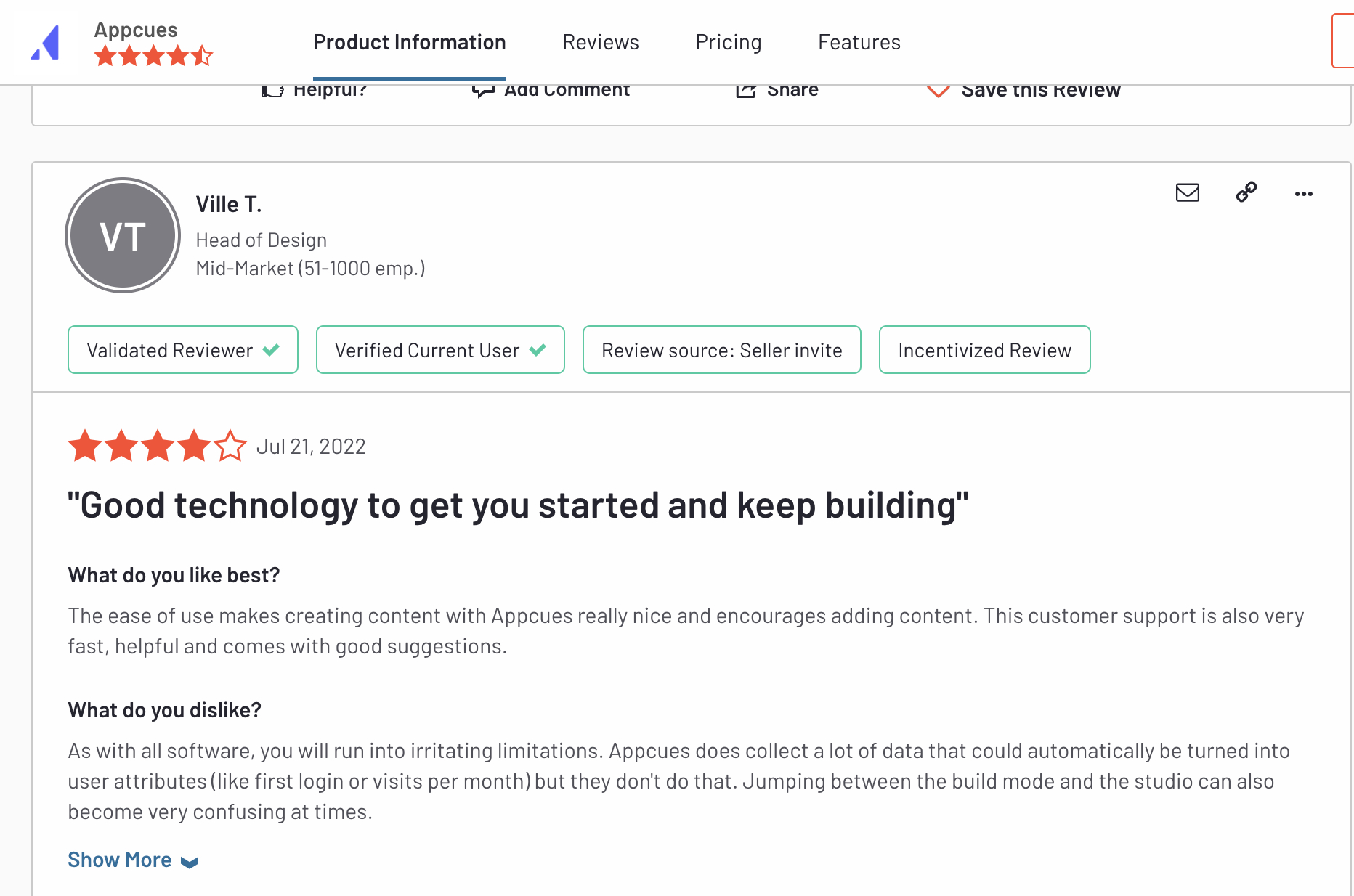
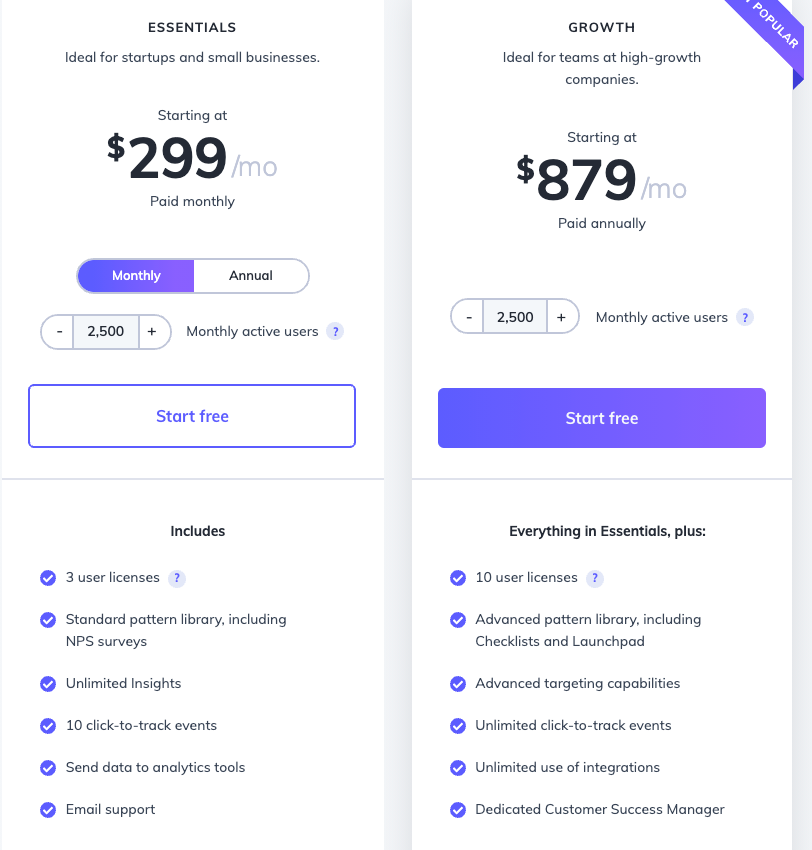
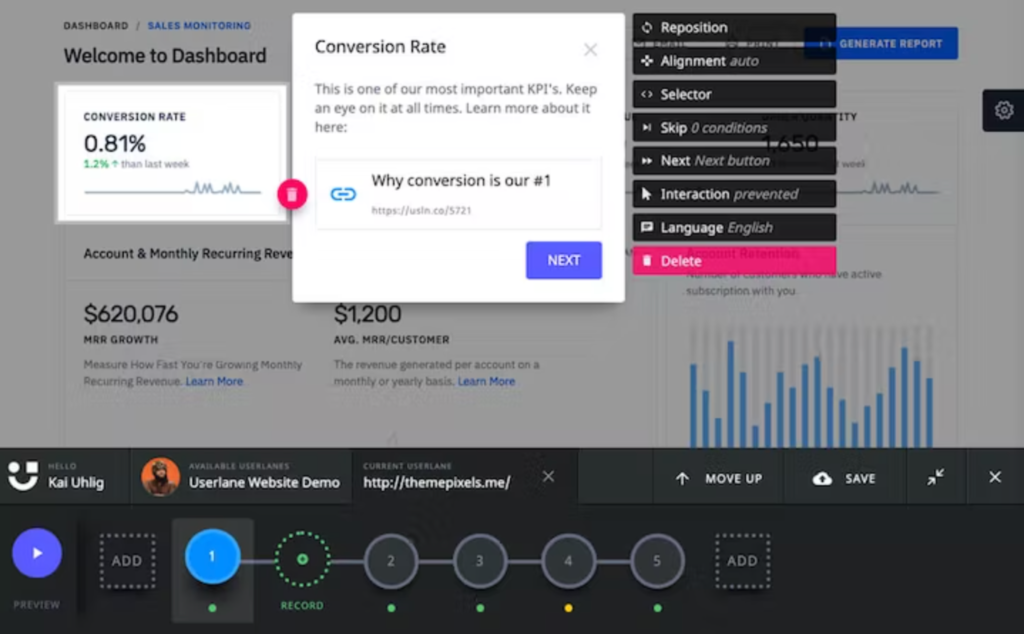
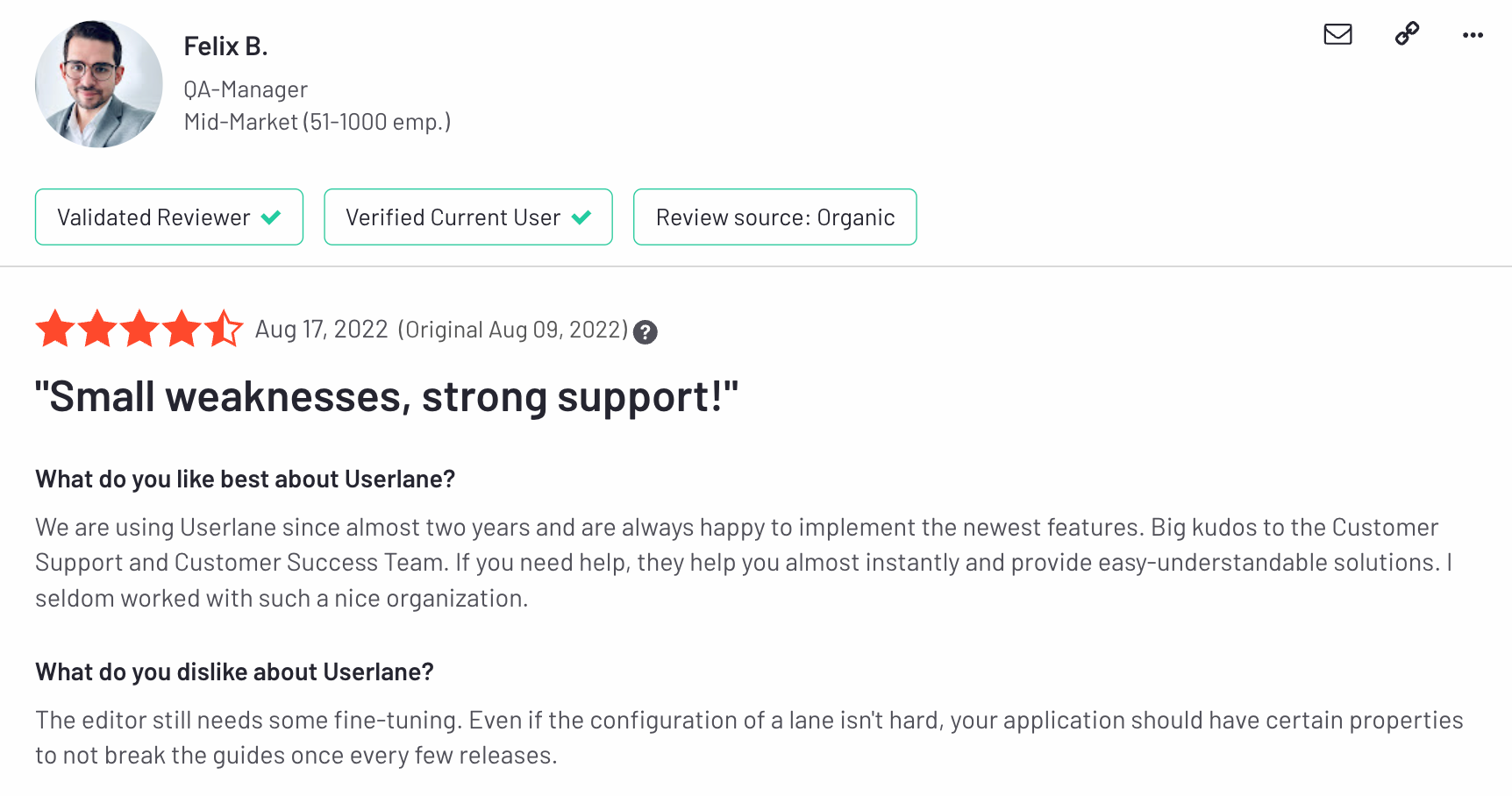
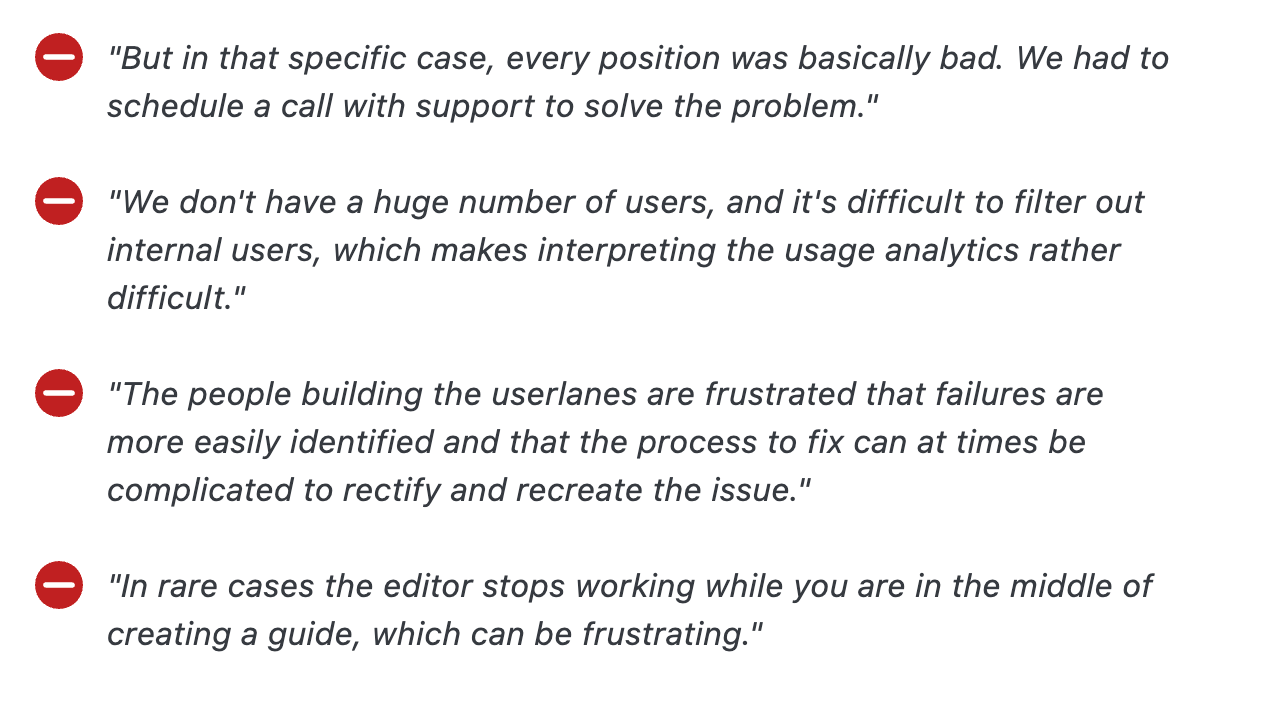
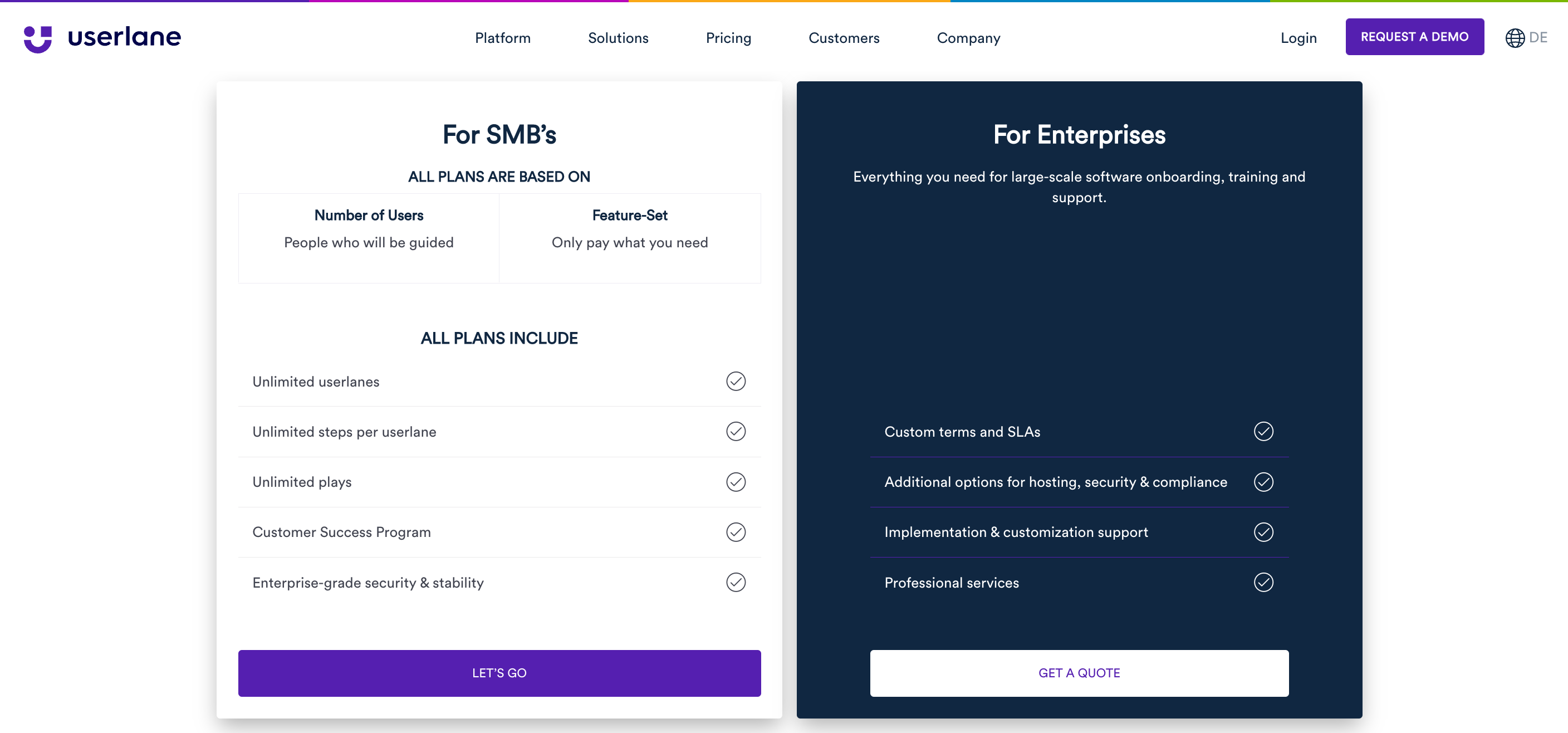
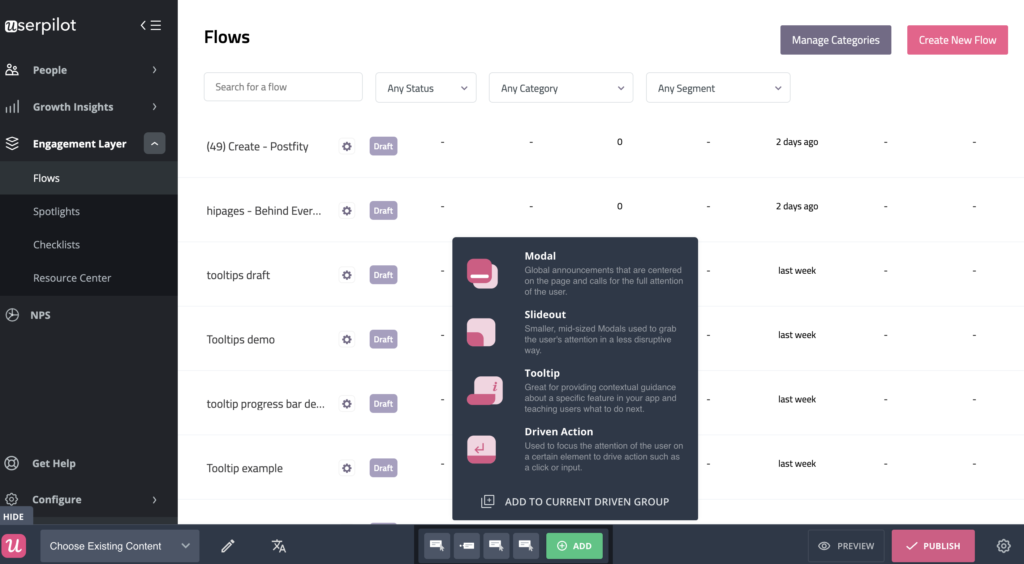


![50+ Best User Onboarding Tools for SaaS [Updated for 2025 & Categorized] cover](https://blog-static.userpilot.com/blog/wp-content/uploads/2025/03/50-best-user-onboarding-tools-for-saas-updated-for-2025-categorized_50c8cd964d43b8851233b37c15ec9e73_2000-1024x670.png)


